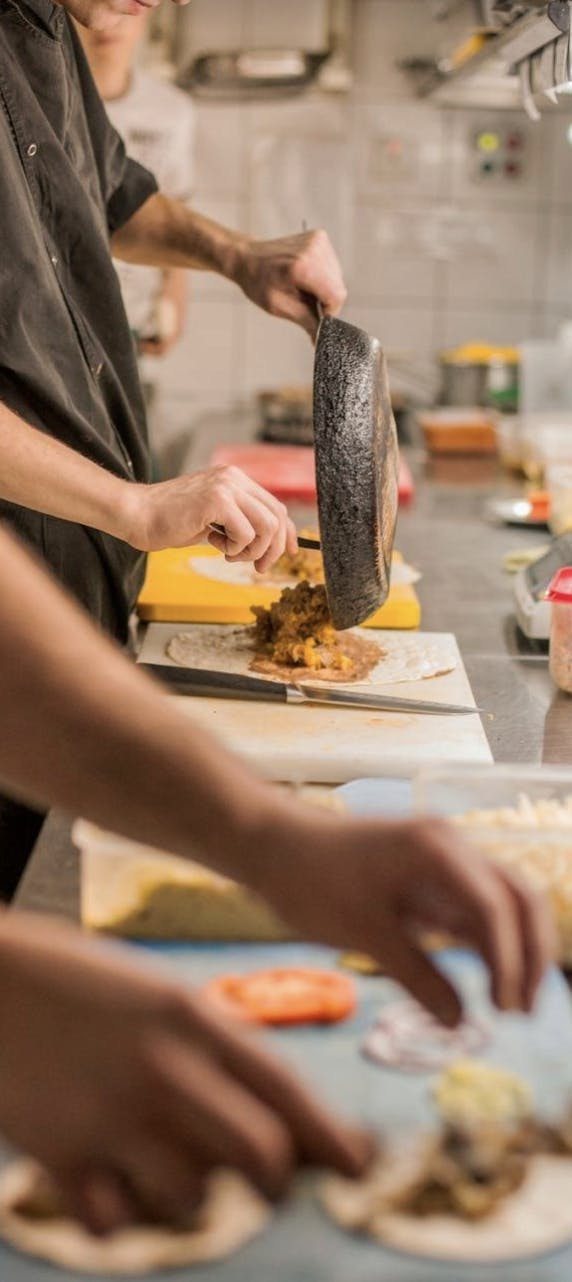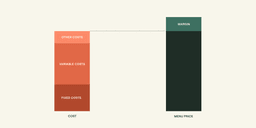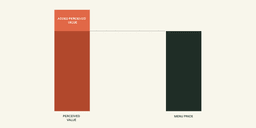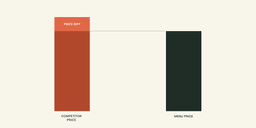Menu Pricing Tactics: Boosting Restaurant Profitability
Table of Contents
CloudKitchens
How many tacos can be delivered from a 1000sqft restaurant?
The same amount as a 200sqft ghost kitchen.
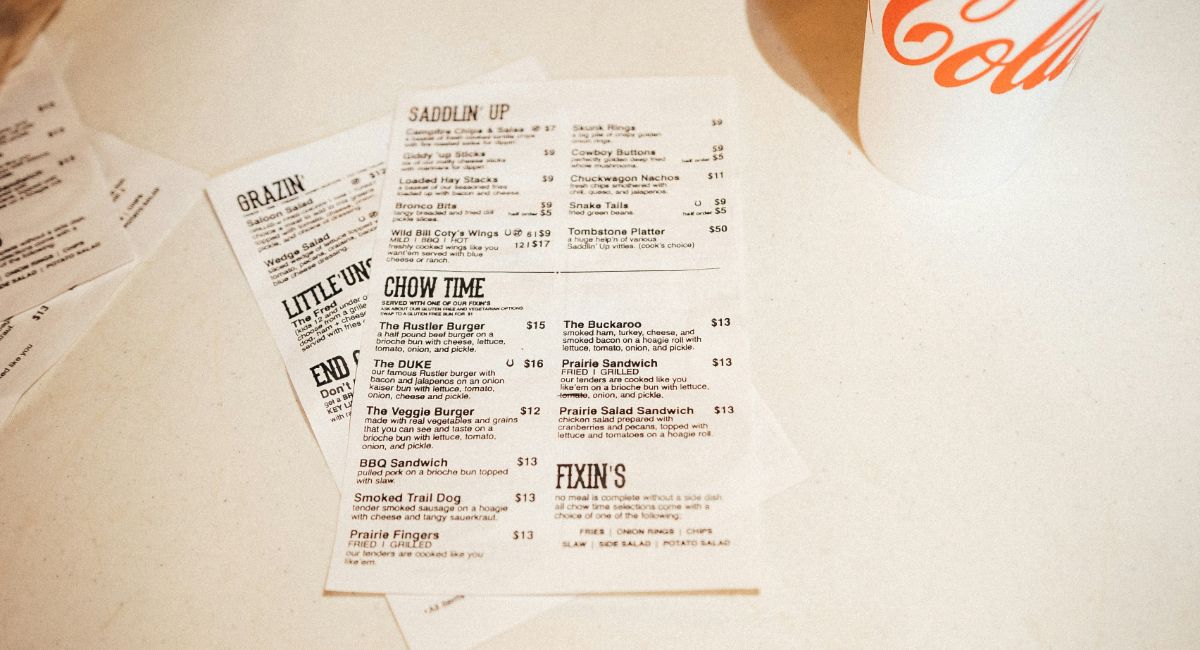
Effective menu pricing strategies, tactics & tips
Whether you operate a buzzy food truck or offer your family’s Sicilian dishes for delivery, you know that a large part of a restaurant’s success is smart menu pricing tactics.
The trick is to appease your primary customer base and attract new patrons while also increasing your profits. And that’s easier said than done—until now.
Let’s cook up a smart strategy that may boost your bottom line and satisfy your customers.
Why is smart menu pricing important?
Food costs have skyrocketed since the onset of the pandemic.
Post-COVID inflation, coupled with a stormy supply chain, has forced restaurants to follow suit. The National Restaurant Association reports that menu prices have soared by 24% since 2020—and many fear inflation will persist.,
The possible consequences of raising your menu prices to meet higher food costs may be obvious: You might turn off both loyal and prospective customers and send them packing to a more economical option. Yet, pricing your menu too low may drive away customers who are suspicious of eats that seem a tad too cheap.
Whether you have a popular establishment or you’re exploring restaurant ideas, the potential benefits of effective menu pricing, however, are impressive:
- Maximized profits
- Elevated customer perception and confidence
- Deepened customer loyalty
- Increased sustainability
5 Strategies for Pricing Your Menu Right
Ready to reap these rewards? Consider these tactics.
- Cost-Plus Pricing
- Valued-Based Pricing
- Competitive Pricing
- Price Skimming
- Price Penetration
Additional Pricing Tips:
- Psychological Pricing Strategy
- Bundling
- Promotions
1. Cost-Based / Plus Pricing (Mark-Up Pricing)
Do the math!
Naturally, smart menu pricing requires a calculator. This strategy involves totaling up all the unit costs such as ingredient cost, and fixed overheads including restaurant rental, kitchen labor, and service staff, then adding a fixed mark-up percentage as the margin.
The following must be considered for every menu option:
- Food ingredient costs (variable cost): It’s important to have an accurate ingredient cost for each menu item. This should take into account economic circumstances and ingredients whose prices fluctuate with the seasons.
- Overhead (fixed cost): Overhead typically refers to operational costs like rent, labor, license fees, and insurance.
- Target profit margin: Having a solid sense of your optimal profit margin enables you to modify prices to help you achieve your goals.
You can then arrive at a ballpark number with this simple, cost-based pricing calculation:
| [ Food ingredient costs + Overhead ] x Mark up % = Price of the menu item |
- Pros: Much easier to implement and can always ensure a healthy margin against the cost.
- Cons: Neglected customer considerations and their willingness to pay, particularly evident in seasonal seafood items on the menu. While this approach prevents restaurant losses, the pricing might exceed diners’ expectations. Additionally, it overlooks competitor pricing, risking customer loss, especially in online delivery where price comparison is effortless.
2. Value-Based Pricing
In this strategy, your “target audience” or diner dictates plenty, including the dishes you feature and their price points. By understanding your customers’ perceived value, you are able to determine what your customers are willing to pay.
If you’ve been running an operation for some time, you’re probably familiar with your customer base. Nonetheless, it’s vital to refine your market as you revamp your menu pricing (this might be even more critical if you’re in the initial stages of starting a restaurant). In addition to identifying your audience’s age, family size, and, importantly, income level, also determine their:
- Lifestyle
- Food preferences
- Dining habits
- Values
These details can help you figure out how much you can dial up or down your prices without sacrificing customer loyalty. It may also inspire you to broaden your menu offerings, omit items that aren’t aligned with your customer’s expectations (and reduce food waste while you’re at it), and give you a leg up on the competition—a topic we’ll turn to next.
- Pros: Menu pricing aligns better with diners, creating a higher perceived value. This approach has the potential to generate more profit and fortify the brand against attacks on pricing from competitors.
- Cons: Might not benefit all the menu items where there is not much differentiation.
3. Competitive Pricing
Offering a medium pizza for $32 in a city where the average price of a large pie is $25 may sink you in an industry that’s notorious for its risks and challenges.
Examining your competition will provide you with baseline pricing that’s acceptable in your niche and region. With this information in hand, you may choose to:
- Co-operative pricing: Price-match your direct and indirect restaurant competition
- Aggressive pricing: If increase or lower the price, try to increase the distance from your competitors’ menu pricing to either gain more customers (volume) or gain margin
- Dismissive pricing: If you are the market leader for the cuisine or dishes in the neighborhood, you can adopt any price you wish to set the benchmark without reacting to your competitors
- Offer “bundle pricing,” or multiple items at a discounted price (i.e., that medium pizza for $32, but it includes a salad and breadsticks)
Keeping an eye on your competition can also help you identify food trends in your neighborhood, whether it’s Birria tacos or Maitake mushrooms—and perhaps inspire you to capitalize on them.
- Pros: Simpler to adjust and implement, offering the potential to increase margins or establish market leadership through strong restaurant branding, safeguarding against future competition.
- Cons: Requires dedicated time and effort to monitor competitors’ menu pricing changes. Continuous efforts to outdo competitors may lead to a price war, compromising the restaurant’s ability to maintain profitability.
4. Price Skimming
Price skimming is a tactic wherein a restaurant introduces novel menu items, leveraging their distinctiveness to command premium prices initially. Over time, as competitors adopt similar offerings, the initial restaurant must adjust prices.
For instance, a restaurant may launch a burger with impossible meat targeting non-meat eaters. Initially, it can charge a premium, but as competitors follow suit, the pricing dynamics change. Being price-sensitive, customers may resist overcharging.
- Pros: Draw attention to the restaurant’s new offering and ability to increase margin significantly, thus it helps to recoup the costs.
- Cons: Other eateries can swiftly replicate and present identical menu items, erasing distinctiveness and hindering the capacity to set higher prices.
5. Penetration Pricing
Restaurants adopt a price penetration strategy in their menu pricing to swiftly build a large customer base. This approach involves offering menu items at very low prices, making it attractive to a broad audience and encouraging quick adoption by a large number of diners. The goal is to capture a significant market share and establish the restaurant brand as a cost-effective and accessible choice in the competitive landscape. This strategy is often employed by Quick Service Restaurants (QSRs) and establishments operating within large retail environments like Costco.
- Pros: The affordable pricing is a clear choice for daily customers seeking value, especially during breakfast and lunch, fostering a loyal customer base.
- Cons: A drawback of this approach is entering into a price war, establishing a precedent for lower prices. This situation may pose challenges for the restaurant brand to implement price increases in the future.
| Pricing strategy | Pros | Cons |
|---|---|---|
| Cost-Plus Pricing | Much easier to implement and can always ensure a healthy margin against the cost. | Neglected customer preferences, especially in seasonal items, risking higher pricing perception. |
| Valued-Based Pricing | Menu pricing enhances value perception, boosting profits and fortifying the brand. | Might not benefit all the menu items where there is not much differentiation. |
| Competitive Pricing | Simpler to adjust and implement, offering the potential to increase margins or establish market leadership through strong restaurant branding, safeguarding against future competition. | Monitoring competitors is vital. Constantly outdoing them risks a detrimental price war. |
| Price Skimming | Draw attention to the restaurant’s new offering and ability to increase margin significantly, thus it helps to recoup the costs. | Competitors can rapidly duplicate menu items, erasing uniqueness and limiting price flexibility. |
| Price Penetration | Affordable pricing attracts loyal daily customers, especially during breakfast and lunch. | Entering a price war sets a precedent for lower prices. |
Additional Pricing Tips:
1. Play with the Psychological Pricing Strategy
Emotion plays a crucial role in purchasing decisions, so consider these psychological pricing methods:
Charm pricing
We’ve all fallen prey to “charm pricing,” or the strategy of pricing goods that end with an odd number; $9.99 just seems significantly more reasonable (or cheaper) than $10.00—even though the difference is a single cent. There’s science behind this: the human mind tends to zero in on the first, farthest left number that appears in a series of digits. Experiment with this tactic and watch how it affects your sales.
Anchor pricing:
Anchor pricing places a higher-priced item adjacent to the entry you truly want to market. For example, an addition to a salad, like grilled steak, would be priced at $9.99 next to an “add on” of chicken for $7.99. To the customer’s eye, chicken is a much more affordable selection, even if the cost for you is negligible. Another example, adding more expensive items on the top of the menu can create the perception that the remaining items are relatively more affordable, leading to increased orders and sales over time.
- Pros: This approach proves lucrative when it aligns with customer expectations and perceived value. It also expedites decision-making during menu item selection.
- Cons: The perceived value among customers may shift, potentially diluting the brand, as it may be associated more with lower-cost establishments such as QSRs and diners.
2. Don’t Forget about Bundle Pricing
Prominent instances include fast-food giants like McDonald’s, KFC, and Burger King, bundling burgers, fries, and drinks at discounted rates compared to individual à la carte items. This strategy enhances perceived value, boosting overall menu sales. Psychological pricing, such as $7.99 and $10.99, further accentuates the value proposition.
- Pros: Boosts average order value, facilitates menu exploration, and reduces operational expenses through timely preparation.
- Cons: May reduce the overall profit margin per item; necessitates vigilant cost management to prevent deficits.
3. Leverage on Promotions
Restaurants can strategically deploy promotions to enhance sales by drawing in a larger customer base. Well-designed promotions, including discounts, loyalty programs, and special events, foster a perception of value, promote customer loyalty, and contribute to overall revenue growth. Examples include holiday dinner promotions and discounted prices on specific weekend nights to boost sales during lower customer turnouts.
- Pros: Rapidly boosts sales and attracts more customers by enhancing the perceived value of regular favorites.
- Cons: Extended promotions can impact margins and stress restaurant and kitchen staff. It may also influence customer behavior, creating a pattern of selective dining. A continuous stream of promotions might diminish the perceived value, potentially harming the restaurant brand in the long run.
Lastly, weigh the idea of limited-time options—say, a discounted price on a holiday special or a dish made with seasonal ingredients (like eggnog cheesecake). Limited-time options can cause customers to act with a sense of urgency.
Assess your demand and make a seasonal update
If you’re testing the waters of launching a food business and/or scouting out commercial kitchens, you may have to increase your menu prices gradually and in a manner that’s attuned to your target customer’s budget.
On the other hand, if you find your online orders going off the second you’re open for business for the day, you’re in a prime position to ask for higher prices.
Not quite there yet? Weigh the idea of bringing in customers by offering off-peak discounts on certain dishes, such as early bird and Happy Hour specials. This can be a terrific way to entice new clientele and compel them to return for full-priced options.
Elevate your food business with CloudKitchens
Successful menu pricing isn’t intuitive, but once you discover the magic number(s) for your menu, you may see an uplift in business—and more dough in your pocket.
CloudKitchens can help accelerate your growth. Our revolutionary ghost kitchens were designed to help entrepreneurs like you by diminishing overhead costs and streamlining delivery options. Plus, with software that provides date-fueled insights, we can help you optimize your menu prices and make your operations more efficient.
Turn up the burner on your food business with CloudKitchens.
Explore ghost kitchen locations across the US:
- Ghost kitchens in San Francisco
- Ghost kitchens in LA
- Ghost kitchens in NYC
- Ghost Kitchens in Toronto
- Ghost Kitchens in Atlanta
- Ghost Kitchens in Dallas
- Ghost Kitchens in Chicago
- Ghost Kitchens in Denver
- Ghost Kitchens in Miami
| DISCLAIMER: This information is provided for general informational purposes only and the content does not constitute an endorsement. CloudKitchens does not warrant the accuracy or completeness of any information, text, images/graphics, links, or other content contained within the blog content. We recommend that you consult with financial, legal, and business professionals for advice specific to your situation. |
Sources:
Center for Economic and Policy Research. Since the pandemic, food prices have risen 23.5 percent; people the NYT interviews have seen much sharper increases. https://cepr.net/since-the-pandemic-food-prices-have-risen-23-5-percent-people-the-nyt-interviews-have-seen-much-sharper-increases/
National Restaurant Association. Menu prices.
https://restaurant.org/research-and-media/research/economists-notebook/economic-indicators/menu-prices/
Bankrate. Survey: higher inflation could persist through at least 2024.
https://www.bankrate.com/banking/federal-reserve/economic-indicator-survey-inflation-july-2023/
Chef Works. 6 reasons why you should raise your menu prices.
https://blog.chefworks.com/uniforms/6-reasons-why-you-should-raise-your-restaurant-prices/
Upmenu. Restaurant menu pricing: 10+ tips to boost menu profit. https://www.upmenu.com/blog/restaurant-menu-pricing/
Binwise. Why do restaurants fail? Restaurant failure statistics. https://home.binwise.com/blog/restaurant-failure-rate
TouchBistro. Restaurant prices on the rise: 8 ways to navigate menu price inflation.
https://www.touchbistro.com/blog/how-to-navigate-restaurant-menu-price-inflation/
Eposnow. Restaurant pricing: proven strategies to set your prices.
https://www.eposnow.com/us/resources/restaurant-pricing/
Deal Hub. Bundle pricing. https://dealhub.io/glossary/bundle-pricing/
HubSpot. Psychological pricing and the big-time boost it offers businesses. https://blog.hubspot.com/sales/psychology-of-price
Business. The rule of 9’s: will charm pricing work for your business?
https://www.business.com/articles/will-charm-pricing-work-for-your-business/
The 5 most common pricing strategies. https://www.bdc.ca/en/articles-tools/marketing-sales-export/marketing/pricing-5-common-strategies
More insights & stories
There’s more where that came from.
Get in the know and check out our additional insights
